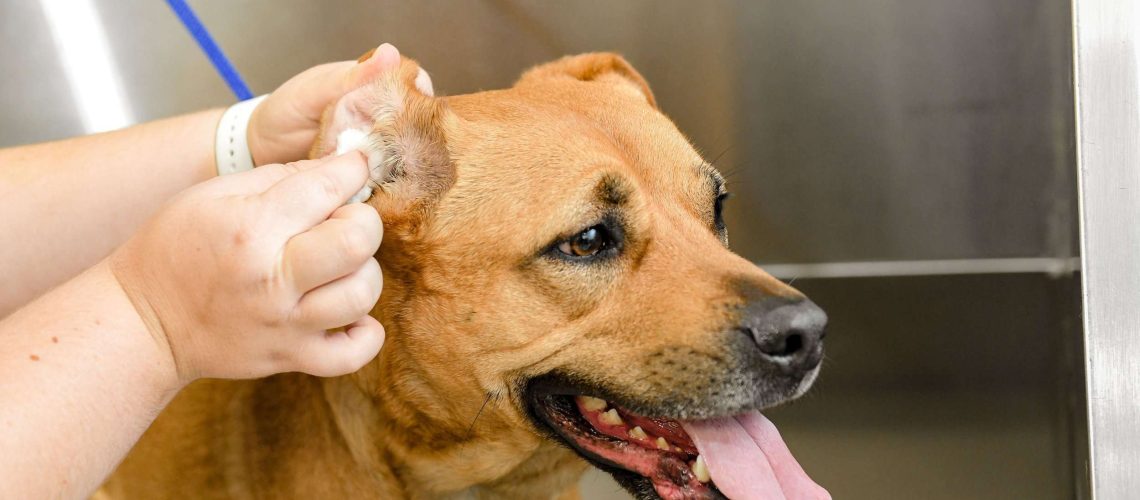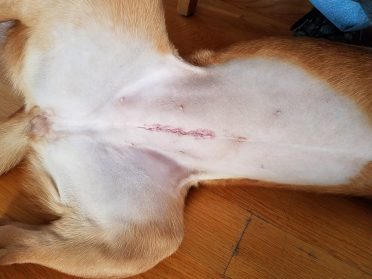Key Takeaways:
- Ear yeast infections in dogs are caused by an overgrowth of yeast, typically the Malassezia species.
- Symptoms of ear yeast infections in dogs include itching, redness, discharge, and a foul odor.
- Certain factors can increase a dog's risk of developing an ear yeast infection, such as allergies, moisture in the ears, and immune system issues.
- Treatment for ear yeast infections in dogs often involves cleaning the ears, using antifungal medications prescribed by a veterinarian, and addressing any underlying causes.
- Preventing ear yeast infections in dogs can be done by keeping their ears clean and dry, avoiding irritants or allergens, and maintaining overall good hygiene and health.
Are you a dog lover? Do you want to ensure that your furry friend is always happy and healthy? Well, then it's time to delve into the fascinating world of ear yeast infections in dogs. Understanding this topic is essential for any responsible pet owner, as these infections can cause discomfort and even lead to more serious health issues if left untreated. By learning about ear yeast infections, you'll be equipped with the knowledge to detect the early signs, prevent them from occurring, and provide proper care for your canine companion. So let's embark on this journey together and unlock the secrets to keeping your dog's ears clean and infection-free!
Understanding Ear Yeast Infections in Dogs
Ear yeast infections are a common problem in dogs. They occur when the yeast, a type of fungus, grows excessively in the dog's ears. Yeast is normally present in small amounts on the skin and in the ears of dogs, but certain factors can cause it to multiply rapidly and lead to an infection.
Yeast thrives in warm and moist environments, making a dog's ears an ideal breeding ground. Factors that can contribute to ear yeast infections include allergies, moisture or wax buildup in the ears, poor hygiene, and underlying health conditions.
Causes of Ear Yeast Infections in Dogs:
- Allergies: Dogs with allergies are more prone to ear yeast infections. Allergies can be caused by food, environmental factors like pollen or dust mites, or even certain materials.
- Moisture/Wax Buildup: Excessive moisture or wax accumulation in the dog's ears can create a favorable environment for yeast growth. This can happen if water gets trapped during bathing or swimming or if the dog has excessive earwax production.
- Poor Hygiene: Lack of regular cleaning and grooming of the ears can contribute to the development of yeast infections. Cleaning your dog's ears regularly helps remove excess wax and debris that may promote yeast growth.
- Underlying Health Conditions: Certain health conditions like hormonal imbalances, immune system disorders, or diabetes can weaken a dog's immune system and make them more susceptible to ear yeast infections.
Anatomy of a Dog's Ear:

Dog ears have three main parts: the outer ear, middle ear, and inner ear. The outer ear includes the visible part of the ear flap and the ear canal. The middle ear contains the eardrum and small bones that transmit sound vibrations. The inner ear is responsible for maintaining balance.
Understanding the anatomy of a dog's ear can help in identifying potential areas where yeast infections may occur. Most yeast infections affect the external part of the ear canal, but in severe cases, it can spread to the middle or inner ear.
Recognizing Symptoms of Ear Yeast Infections in Dogs
Common Symptoms
If your dog has an ear yeast infection, you may notice some common symptoms. One of the most noticeable signs is excessive scratching or rubbing of the ears. Your dog may also shake their head frequently or tilt it to one side. Another symptom is a strong odor coming from the ears, often described as a yeasty or musty smell. Additionally, you might observe redness, swelling, or discharge in the ear canal.
Less Common Symptoms
In some cases, dogs with ear yeast infections may exhibit less common symptoms. These can include loss of balance or coordination, hearing loss, and even changes in behavior such as irritability or depression. It's important to pay attention to any unusual behaviors your dog may be displaying as they could indicate an underlying ear infection.
What to Do if You Suspect an Ear Yeast Infection
If you suspect that your dog has an ear yeast infection based on these symptoms, it's essential to seek veterinary care. A veterinarian will be able to diagnose the infection and recommend appropriate treatment options.
Tips for Preventing Ear Yeast Infections
- Clean your dog's ears regularly using a veterinarian-recommended ear cleaner.
- Dry your dog's ears thoroughly after swimming or bathing.
- Avoid exposing your dog to environments with excessive moisture or humidity.
- Avoid using cotton swabs or other objects to clean your dog's ears, as this can push debris further into the ear canal and potentially cause injury.
- Maintain regular grooming habits and keep your dog's fur around the ears trimmed short.
Treatment Options for Ear Yeast Infections
If your dog is diagnosed with an ear yeast infection, the veterinarian may recommend a combination of treatments. This can include cleaning the ears with a prescribed solution, applying topical antifungal medications, and in some cases, oral antifungal medications. It's important to follow the veterinarian's instructions carefully and complete the full course of treatment to ensure effective resolution of the infection.
Potential Health Problems from Untreated Ear Yeast Infections
If left untreated, ear yeast infections in dogs can lead to various health problems. The constant scratching and rubbing can cause trauma to the ears, leading to secondary bacterial infections. Chronic ear infections can also result in damage to the eardrum or middle ear structures, potentially causing hearing loss. Additionally, untreated ear yeast infections can be painful for dogs and may affect their overall quality of life. Therefore, it is crucial to seek prompt veterinary care if you suspect your dog has an ear yeast infection.
Dog Breeds Prone to Ear Yeast Infections
Common Dog Breeds Susceptible to Ear Yeast Infections
When it comes to ear yeast infections, certain dog breeds are more prone to developing this uncomfortable condition. Breeds with floppy ears, such as Cocker Spaniels, Basset Hounds, and Beagles, have a higher risk due to the limited airflow in their ear canals. Additionally, dogs with excessive hair growth in their ears, like Poodles and Shih Tzus, may also be more susceptible.
Furthermore, breeds that love water activities like Labradors and Retrievers are at an increased risk of developing ear yeast infections. The moisture trapped inside their ears after swimming or bathing creates a favorable environment for yeast overgrowth. It's important for owners of these breeds to be vigilant in preventing and treating ear yeast infections.
Preventing Ear Yeast Infections in Dogs
To keep your furry friend's ears healthy and free from yeast infections, regular preventive measures should be taken. First and foremost, it is crucial to keep your dog's ears clean and dry. Use a gentle pet-specific ear cleaner recommended by your veterinarian to remove excess wax and debris.
Additionally, if your dog loves water activities, make sure to thoroughly dry their ears after swimming or bathing. Gently wipe the outer part of the ear with a soft towel or use a pet-specific drying solution designed for this purpose. Avoid inserting cotton swabs or any other objects into the ear canal as it may cause injury or push debris further inside.
If your dog has excessive hair growth in their ears, consider regular grooming sessions where you carefully trim the hair around the ear opening. This helps improve airflow and reduces the chances of moisture accumulation.
Treatments for Ear Yeast Infections in Dogs
If your dog is already suffering from an ear yeast infection, prompt treatment is essential to alleviate their discomfort and prevent further complications. The first step is to consult with a veterinarian who can accurately diagnose the infection and recommend appropriate treatment.
Typically, treatment involves a combination of cleaning the ears with a prescribed antifungal solution and administering antifungal medications orally or topically. It's important to follow the veterinarian's instructions carefully and complete the full course of treatment, even if symptoms improve before completion.
In some cases, if the infection is severe or recurring, your veterinarian may recommend additional diagnostic tests to identify any underlying causes or contributing factors. This could include allergy testing or examining the dog's diet to rule out potential allergens that may be triggering the infections.
Potential Health Problems from Untreated Ear Yeast Infections in Dogs
Ignoring or neglecting ear yeast infections in dogs can lead to various health problems that can significantly impact their well-being. If left untreated, these infections can spread beyond the ears and affect other parts of the body, such as the skin or even the bloodstream.
Untreated ear yeast infections can cause intense itching and discomfort for dogs, leading to excessive scratching and head shaking. This can result in self-inflicted injuries like skin abrasions or hematomas (blood-filled swellings) on their ears. Furthermore, chronic ear infections can damage delicate structures within the ear, potentially leading to hearing loss.
In some cases, untreated ear yeast infections may also serve as a gateway for secondary bacterial infections. These secondary infections can cause more severe symptoms like foul odor, pus discharge, swelling, and pain. Therefore, it is crucial to address ear yeast infections promptly to ensure your furry friend's overall health and well-being.
Preventing Ear Yeast Infections in Dogs
As a responsible dog owner, it is important to take proactive measures to prevent ear yeast infections in your furry friend. One of the key steps you can take is to regularly clean your dog's ears. This can be done by gently wiping the outer part of the ear with a damp cloth or using specialized ear cleaning solutions recommended by your veterinarian. It is crucial to avoid inserting anything deep into the ear canal as this can cause damage.
In addition to regular cleaning, keeping your dog's ears dry is essential in preventing yeast infections. Moisture provides an ideal environment for yeast to thrive, so after bathing or swimming, make sure to thoroughly dry your dog's ears using a clean towel. You can also use a pet-friendly drying solution specifically designed for canine ears.
Regular Cleaning Routine
To establish a regular cleaning routine for your dog's ears, follow these simple steps:
- Gently hold your dog's head and lift one ear flap.
- Dampen a cotton ball or pad with an approved ear cleaning solution.
- Gently wipe the visible part of the inner ear and the folds of the outer ear.
- Repeat on the other ear.
Avoiding Excessive Moisture
To prevent excessive moisture in your dog's ears:
- Avoid letting your dog swim in dirty or stagnant water sources.
- If your dog loves swimming, consider using specially designed waterproof ear covers to keep water out during water activities.
- After bathing, ensure thorough drying of the ears using a clean towel or pet-friendly drying solution.
Treatments for Ear Yeast Infections in Dogs
If your dog develops an ear yeast infection, prompt treatment is crucial to alleviate discomfort and prevent further complications. It is important to consult a veterinarian for an accurate diagnosis and appropriate treatment plan. The most common treatments for ear yeast infections in dogs include topical medications and oral antifungal drugs.
Topical Medications
Topical medications are often prescribed by veterinarians to treat ear yeast infections. These medications usually come in the form of ointments or drops that need to be applied directly into the ear canal. They work by eliminating the excess yeast and reducing inflammation. It is essential to follow the veterinarian's instructions carefully when administering these medications.
Oral Antifungal Drugs
In more severe cases or when topical treatments alone are not sufficient, veterinarians may prescribe oral antifungal drugs. These medications help eliminate the yeast from within the body, providing systemic relief. It is important to strictly adhere to the prescribed dosage and duration of treatment as advised by the veterinarian.
Potential Health Problems from Untreated Ear Yeast Infections in Dogs
Ignoring or neglecting an ear yeast infection in your dog can lead to various health problems that can significantly impact their well-being. If left untreated, these infections can spread beyond the ears and affect other parts of your dog's body, leading to more severe conditions.
Secondary Bacterial Infections
An untreated ear yeast infection can create an ideal environment for bacteria to thrive. This can result in secondary bacterial infections that cause additional discomfort and may require more aggressive treatment approaches.
Hearing Loss
Prolonged presence of a yeast infection in the ears can lead to hearing loss in dogs. The inflammation and damage caused by the infection can affect the delicate structures responsible for hearing, resulting in partial or complete loss of hearing abilities.
Chronic Discomfort
Untreated ear yeast infections can cause chronic discomfort for your dog. The itching, redness, and inflammation can persist, leading to constant scratching and discomfort. This can significantly impact their quality of life and overall well-being.
Early Intervention is Key
To prevent these potential health problems, it is crucial to seek veterinary attention at the first signs of an ear yeast infection in your dog. Early intervention ensures prompt treatment and a higher likelihood of successful resolution without complications.
In conclusion, ear yeast infections can be common in dogs and may cause discomfort and irritation. It is important for dog owners to recognize the symptoms and seek veterinary care to effectively treat and prevent these infections.
How do you get rid of a yeast infection in a dog's ear?
In the case that your dog has a yeast infection in the external ear canal, the veterinarian may recommend a topical ointment or cream that contains antifungal properties. Two commonly used antifungal medications, Miconazole and Ketoconazole, have proven to be effective in treating this condition.
What foods cause yeast infections in dogs ears?
If certain dogs consume certain ingredients like chicken, wheat, corn, or other specific substances, it can cause an allergic reaction that disrupts the natural balance and promotes the growth of yeast. If your pet has issues with yeast in their ears, consider changing their diet to avoid common triggers.
What happens if a dog ear yeast infection goes untreated?
This condition can cause itching, redness, and irritation in the affected area of your dog's skin. If left untreated, yeast infections in a dog's ear can also lead to hearing loss.
How do you treat a yeast infection in a dog's ear without going to the vet?
If your dog has an ear infection called otitis externa, there are natural remedies you can use to manage it, such as mullein drops, green tea, apple cider vinegar, and calendula. However, if the infection is more severe like otitis media or interna, it is best to consult a holistic veterinarian to determine the appropriate treatment.
Can I use Monistat in my dog's ears for yeast infection?
Using Monistat can be messy, but it is commonly used by women. However, the active ingredient in Monistat is also safe for dogs. When applied correctly, a combination of this topical cream and hydrocortisone cream can often effectively treat yeast infections in dogs' ears.
Does yogurt help with yeast in dogs ears?
Not only are probiotic yogurts safe for humans, but they are also safe for dogs. This is advantageous because it promotes a healthy gut. Additionally, the probiotics in yogurts can assist dogs in combating yeast infections, which can lead to issues with the ears and skin.

















